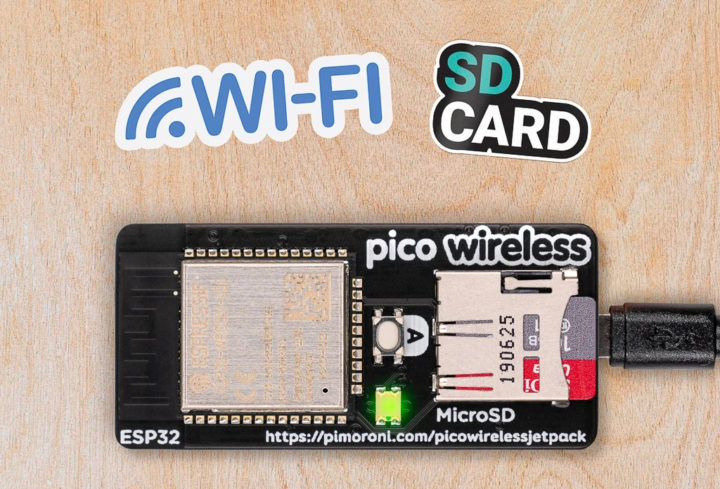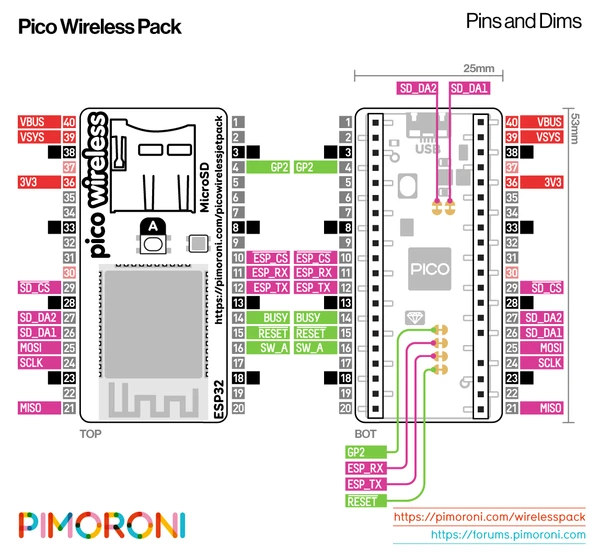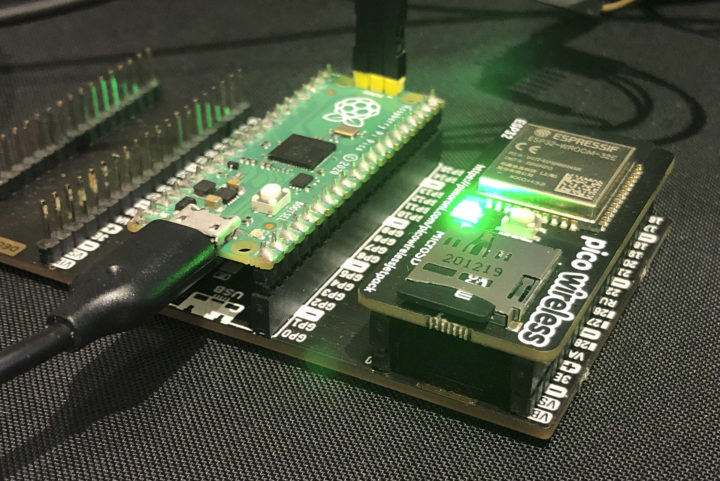Pimoroni Pico Wireless Pack is an add-on board for Raspberry Pi Pico adding a MicroSD card socket and ESP32 WiFi & Bluetooth module to the popular MCU board.
While it’s a nice idea to add wireless connectivity to Raspberry Pi Pico, ESP32 is a dual-core Xtensa LX6 processor clocked at 160 to 240 MHz with WiFi, Bluetooth, and plenty of I/Os that should be able to handle most tasks better than Raspberry Pi RP2040 dual-core Cortex-M0+ processor clocked at 48 MHz by default, although we’ve also seen it overclocked up to 252 MHz.

Pico Wireless Pack specifications:
- Wireless module – ESP32-WROOM-32E WiFi 4 & Bluetooth 4.2/5.x module with PCB antenna, 4 MB SPI flash (module connected via SPI)
- Storage – MicroSD card slot
- Pre-soldered female headers for attaching Raspberry Pi Pico
- Misc – 1x tactile button, 1x RGB LED
- Dimensions – ~53 x 25 x 11mm
Sometimes it makes sense to have two chips, as the RP2040 Cortex-M0+ should consume less, which would be beneficial when running on battery, but the Pico board does not include battery support. So I guess the main benefit would be for people having already developed an application on Raspberry Pi Pico, and wanting to connect it to the network.
Pimoroni employee Phil Howard (aka Gadgetoid) showcased the solution on Twitter with a demo serving an HTML file from an SD card over WiFi.
https://twitter.com/Gadgetoid/status/1389964360613761024
That does the job, but you could also just remove the Raspberry Pi Pico board to achieve the same result by powering Pico Wireless Pack with a separate 5V (or is it 3.3V) power source. The software would likely be quite similar since like RP2040, ESP32 can be programmed with the Arduino IDE or MicroPython. Note that Pimoroni provides its own MicroPython firmware. Using the C/C++ SDK for the respective processor would however lead to a fairly different source code.

You’ll find documentation on Pimoroni’s shop where you can also purchase the Pico Wireless Pack board for 12 GBP or about $16.70 US. The price is competitive against Arduino Nano RP2040 Connect, but the best value, if you want WiFi with RP2040 MCU, is probably the $12.95 Wio RP2040 Mini board at this time. In the future, it could prove more interesting to get a USB-powered “ESP32 Pico Wireless” board as well that could work independently and leverage the Raspberry Pi Pico ecosystem.
Via Tom’s Hardware
[Updated – Initially published on May 6, 2021 featuring a prototype of the board, but the post was updated on June 26,2021 with the launch of Pico Wireless Pack]

Jean-Luc started CNX Software in 2010 as a part-time endeavor, before quitting his job as a software engineering manager, and starting to write daily news, and reviews full time later in 2011.
Support CNX Software! Donate via cryptocurrencies, become a Patron on Patreon, or purchase goods on Amazon or Aliexpress





